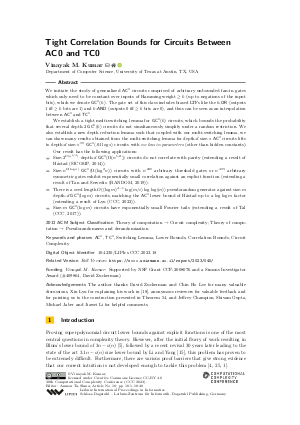@InProceedings{kumar:LIPIcs.CCC.2023.18,
author = {Kumar, Vinayak M.},
title = {{Tight Correlation Bounds for Circuits Between AC0 and TC0}},
booktitle = {38th Computational Complexity Conference (CCC 2023)},
pages = {18:1--18:40},
series = {Leibniz International Proceedings in Informatics (LIPIcs)},
ISBN = {978-3-95977-282-2},
ISSN = {1868-8969},
year = {2023},
volume = {264},
editor = {Ta-Shma, Amnon},
publisher = {Schloss Dagstuhl -- Leibniz-Zentrum f{\"u}r Informatik},
address = {Dagstuhl, Germany},
URL = {https://drops.dagstuhl.de/entities/document/10.4230/LIPIcs.CCC.2023.18},
URN = {urn:nbn:de:0030-drops-182885},
doi = {10.4230/LIPIcs.CCC.2023.18},
annote = {Keywords: AC⁰, TC⁰, Switching Lemma, Lower Bounds, Correlation Bounds, Circuit Complexity}
}

 Creative Commons Attribution 4.0 International license
Creative Commons Attribution 4.0 International license



